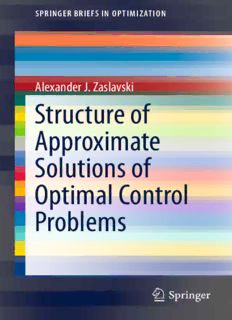Table Of ContentSPRINGER BRIEFS IN OPTIMIZATION
Alexander J. Zaslavski
Structure of
Approximate
Solutions of
Optimal Control
Problems
123
SpringerBriefs in Optimization
SeriesEditors
PanosM.Pardalos
Ja´nosD.Pinte´r
StephenM.Robinson
Tama´sTerlaky
MyT.Thai
SpringerBriefs in Optimization showcases algorithmic and theoretical tech-
niques,casestudies,andapplicationswithinthebroad-basedfieldofoptimization.
Manuscripts related to the ever-growing applications of optimization in applied
mathematics, engineering, medicine, economics, and other applied sciences are
encouraged.
Forfurthervolumes:
http://www.springer.com/series/8918
Alexander J. Zaslavski
Structure of Approximate
Solutions of Optimal Control
Problems
123
AlexanderJ.Zaslavski
DepartmentofMathematics
Technion–IsraelInstituteofTechnology
Haifa,Israel
ISSN2190-8354 ISSN2191-575X(electronic)
ISBN978-3-319-01239-1 ISBN978-3-319-01240-7(eBook)
DOI10.1007/978-3-319-01240-7
SpringerNewYorkHeidelbergDordrechtLondon
LibraryofCongressControlNumber:2013943267
MathematicsSubjectClassification:49J15,90C31,54E35,54E50,54E52
©AlexanderJ.Zaslavski2013
Thisworkissubjecttocopyright.AllrightsarereservedbythePublisher,whetherthewholeorpartof
thematerialisconcerned,specificallytherightsoftranslation,reprinting,reuseofillustrations,recitation,
broadcasting,reproductiononmicrofilmsorinanyotherphysicalway,andtransmissionorinformation
storageandretrieval,electronicadaptation,computersoftware,orbysimilarordissimilarmethodology
nowknownorhereafterdeveloped.Exemptedfromthislegalreservationarebriefexcerptsinconnection
with reviews or scholarly analysis or material supplied specifically for the purpose of being entered
and executed on a computer system, for exclusive use by the purchaser of the work. Duplication of
this publication or parts thereof is permitted only under the provisions of the Copyright Law of the
Publisher’slocation,initscurrentversion,andpermissionforusemustalwaysbeobtainedfromSpringer.
PermissionsforusemaybeobtainedthroughRightsLinkattheCopyrightClearanceCenter.Violations
areliabletoprosecutionundertherespectiveCopyrightLaw.
Theuseofgeneraldescriptivenames,registerednames,trademarks,servicemarks,etc.inthispublication
doesnotimply,evenintheabsenceofaspecificstatement,thatsuchnamesareexemptfromtherelevant
protectivelawsandregulationsandthereforefreeforgeneraluse.
While the advice and information in this book are believed to be true and accurate at the date of
publication,neithertheauthorsnortheeditorsnorthepublishercanacceptanylegalresponsibilityfor
anyerrorsoromissionsthatmaybemade.Thepublishermakesnowarranty,expressorimplied,with
respecttothematerialcontainedherein.
Printedonacid-freepaper
SpringerispartofSpringerScience+BusinessMedia(www.springer.com)
Preface
In this book we study the structure of approximate solutions of optimal control
problemsconsideredonsubintervalsof a realline. We are interestedin properties
ofapproximatesolutionswhichareindependentofthelengthoftheinterval,forall
sufficientlylargeintervals.Theresultsinthisbookdealwiththeso-calledturnpike
property of the optimal control problems. To have this property means, roughly
speaking,thattheapproximatesolutionsoftheproblemsaredeterminedmainlyby
the integrand(objectivefunction)andare essentially independentof the choiceof
intervalandendpointconditions,exceptinregionsclosetotheendpoints.
Turnpike propertiesare well known in mathematicaleconomics. The term was
first coined by P. Samuelson in 1948 when he showed that an efficient expanding
economywouldspendmostofthetimeinthevicinityofabalancedequilibriumpath
(alsocalledvonNeumannpath).Nowitiswellknownthattheturnpikepropertyis
a general phenomenonwhich holds for large classes of variational problems. For
theseclassesofproblems,usingtheBairecategoryapproach,itwasshownthatthe
turnpikepropertyholdsforageneric(typical)problem.
In this book we generalize this result for a general class of optimal control
problems. More precisely, in Chap. 2 of this book we consider a class of opti-
mal control problems (with the same system of differential equations, the same
functional constraints, and the same boundary conditions) which is identified
with the correspondingcompletemetric space of objectivefunctions(integrands).
The main results of Chap. 2 establish the turnpike property for any element of
a set which is a countable intersection of open everywhere dense sets in the
space of integrands.This meansthatthe turnpikepropertyholdsfor mostoptimal
controlproblems(integrands).InChap.3westudyinfinitehorizonoptimalcontrol
problemscorrespondingtothespaceofintegrandsintroducedinChap.2.Aclassof
linearcontrolproblemsisconsideredinChap.4.
Haifa,Israel AlexanderJ.Zaslavski
v
Contents
1 Introduction .................................................................. 1
1.1 InfiniteHorizonVariationalProblems ................................. 1
1.2 TheTurnpikePhenomenon............................................. 5
1.3 StructureofSolutionsofVariationalProblems........................ 7
2 TurnpikePropertiesofOptimalControlProblems ...................... 11
2.1 Preliminaries ............................................................ 11
2.2 TheMainResults ....................................................... 13
2.3 UniformBoundednessofTrajectory-ControlPairs ................... 17
2.4 AuxiliaryResults........................................................ 22
2.5 ProofsofTheorems2.1–2.3and2.5 ................................... 68
3 InfiniteHorizonProblems .................................................. 77
3.1 ExistenceofOptimalSolutions ........................................ 77
3.2 AuxiliaryResults........................................................ 82
3.3 ProofofProposition3.3 ................................................ 85
3.4 ProofofProposition3.4 ................................................ 89
3.5 ProofofTheorem3.6................................................... 91
3.6 ProofofTheorem3.7................................................... 97
3.7 ProofofTheorem3.8................................................... 100
4 LinearControlSystems ..................................................... 105
4.1 TheClassofProblems.................................................. 105
4.2 ProofofProposition4.2 ................................................ 107
4.3 AContinuityProperty .................................................. 111
4.4 ABoundednessProperty ............................................... 116
4.5 TheExistenceandStructureofSolutions.............................. 118
References......................................................................... 125
Index............................................................................... 127
vii
Chapter 1
Introduction
1.1 InfiniteHorizon Variational Problems
Thestudyofoptimalcontrolproblemsandvariationalproblemsdefinedoninfinite
intervals and on sufficiently large intervals has been a rapidly growing area of
research[4,5,8–13,16,18,22–24,27,34–38,40,45–47,50].Theseproblemsarisein
engineering[1,25,53],inmodelsofeconomicgrowth[2,3,12,15,17,24,28,33,39,
41–43,50],ininfinitediscretemodelsofsolid-statephysicsrelatedtodislocationsin
one-dimensionalcrystals[7,44],inthecalculusofvariationsontimescales[29,32]
andinthetheoryofthermodynamicalequilibriumformaterials[14,26,30,31].
Considertheinfinitehorizonproblemofminimizingtheexpression
(cid:2)
T
f(t,x(t),x(cid:2)(t))dt
0
as T grows to infinity where a function x : [0,∞) → Rn is locally absolutely
continuous(a.c.)andsatisfies theinitialconditionx(0) = x0, andf belongsto a
completemetricspaceoffunctionstobedescribedbelow.
Wesaythatana.c.functionx:[0,∞)→Rnis(f)-overtakingoptimalif
(cid:2)
T
limsup [f(t,x(t),x(cid:2)(t))−f(t,y(t),y(cid:2)(t))]dt≤0
T→∞ 0
foranya.c.functiony : [0,∞)→Rnsatisfyingy(0)=x(0).
This notion, known as the overtaking optimality criterion, was introduced in
the economics literature [17,43] and has been used in optimal control theory
[12,24,49,50].
Anothertypeofoptimalitycriterionforinfinitehorizonproblemswasintroduced
byAubryandLeDaeron[7]intheirstudyofthediscreteFrenkel–Kontorovamodel
related to dislocations in one-dimensional crystals. This optimality criterion was
usedin[14,26,30,31,44,47,50].
A.J.Zaslavski,StructureofApproximateSolutionsofOptimalControlProblems, 1
SpringerBriefsinOptimization,DOI10.1007/978-3-319-01240-7 1,
©AlexanderJ.Zaslavski2013
2 1 Introduction
LetI beeither[0,∞)or(−∞,∞).Wesaythatana.c.functionx: I →Rnis
an(f)-minimalsolutionif
(cid:2) (cid:2)
T2 T2
f(t,x(t),x(cid:2)(t))dt≤ f(t,y(t),y(cid:2)(t))dt≤0
T1 T1
foreachT1 ∈ I, eachT2 > T1, andeacha. c. functiony : [T1,T2] → Rn which
satisfiesy(T )=x(T ), i=1,2.
i i
It is easy to see that every (f)-overtaking optimal function is an (f)-minimal
solution.
InChap.1of[50]andin[48]weconsideredafunctionalspaceofintegrandsM
describedbelow.Weshowedthatforeachf ∈ Mandeachz ∈ Rn thereexistsa
bounded(f)-minimalsolutionZ :[0,∞)→RnsatisfyingZ(0)=zsuchthatany
othera. c. functionY : [0,∞) → Rn is not“better”than Z. We also established
that,givenf ∈MandaboundedsetE ⊂Rn,theC([0,T])normsofapproximate
solutionsx : [0,T]→ Rn fortheminimizationproblemonaninterval[0,T]with
x(0),x(T)∈E areboundedbysomeconstantwhichdependsonlyonf andE.
Leta>0beaconstantandψ : [0,∞)→[0,∞)beanincreasingfunctionsuch
thatψ(t)→∞ast→∞.
Denoteby|·|theEuclideannorminthen-dimensionalEuclideanspaceRnand
denote by M the set of all continuousfunctionsf : [0,∞)×Rn ×Rn → R1
whichsatisfythefollowingassumptions:
A(i) Foreach(t,x)∈[0,∞)×Rnthefunctionf(t,x,·): Rn →R1isconvex;
A(ii) Thefunctionfisboundedon[0,∞)×EforanyboundedsetE ⊂Rn×Rn;
A(iii) Foreach(t,x,u)∈[0,∞)×Rn×Rn,
f(t,x,u)≥max{ψ(|x|),ψ(|u|)|u|}−a;
A(iv) ForeachM,(cid:3)>0thereexistΓ,δ >0suchthat
|f(t,x1,u1)−f(t,x2,u2)|≤(cid:3)max{f(t,x1,u1),f(t,x2,u2)}
foreacht∈[0,∞),eachu1,u2 ∈Rnandeachx1,x2 ∈Rnwhichsatisfy
|xi|≤M, |ui|≥Γ, i=1,2, max{|x1−x2|,|u1−u2|}≤δ;
A(v) ForeachM,(cid:3)>0thereexistsδ >0suchthat
|f(t,x1,u1)−f(t,x2,u2)|≤(cid:3)
foreacht∈[0,∞),eachu1,u2 ∈Rnandeachx1,x2 ∈Rnwhichsatisfy
|xi|,|ui|≤M, i=1,2, max{|x1−x2|,|u1−u2|}≤δ.
Description:This title examines the structure of approximate solutions of optimal control problems considered on subintervals of a real line. Specifically at the properties of approximate solutions which are independent of the length of the interval. The results illustrated in this book look into the so-called

